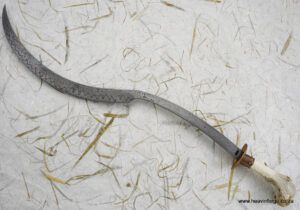October 7, 2024
I Want to Make a Sword!

“I Want to Make a Sword”—How to Encourage Aspiring Bladesmiths
October 7, 2024

“I Want to Make a Sword”—How to Encourage Aspiring Bladesmiths
September 6, 2024
Workshop ergonomics might not seem very important for the part-time bladesmith, but you will still gain interesting tips from this blog post. Ergonomics will evolve with the new tools and equipment you acquire (bladesmiths always need more stuff). Kevin and I have changed the layout of our workshop countless times, and when it comes to moving giant anvils, surface grinders, hydraulic presses, and power hammers, you want to be sure of their positions as you set up your shop. It isn’t easy to move these heavy, semi-permanent machines! Get it right the first time and work around them.
July 14, 2024
Did you know? Bladesmithing dates back over 4,000 years! This ancient art has been passed down generations. Consider dedicating some Sunday time to bladesmithing. Let the hammer’s rhythm guide you and the forge’s glow inspire you.
But remember to balance your enthusiasm with respect for others’ peace and family time.
June 17, 2024
The colours of the steel at various temperatures provide an approximate yet reliable indication of its heat, allowing the smith to adjust their technique accordingly.
June 17, 2024
The “critical temperature” is a pivotal point in the forging process. It is the temperature at which the steel’s crystalline structure transforms, indicated by a bright orange glow. Determining this temperature accurately is crucial, as forging above it can cause the steel to become coarse-grained and weak.
June 16, 2024
The two primary types of forges are gas forges and coal forges. Each type operates differently and offers distinct advantages and challenges. Understanding these differences is key to selecting the right forge for your needs.
June 16, 2024
The properties of steel can be significantly altered through heat treatment processes such as hardening and tempering. These processes manipulate the microstructure of the steel to enhance its performance characteristics.
June 16, 2024
Understanding these parts of a knife not only helps you choose the right knife for your needs but also helps you maintain and appreciate the craftsmanship behind each blade. Whether you’re cutting through a juicy steak, carving wood, or preparing a gourmet meal, knowing the anatomy of your knife will enhance your experience and skill.
June 15, 2024
Regardless of the type, setting your gas forge correctly is crucial to avoid carbon loss and ensure the quality of your blades.
June 15, 2024
We encourage everyone in our community to watch and share our safety video. As we emphasize on YouTube, there’s immense value in learning through demonstration.